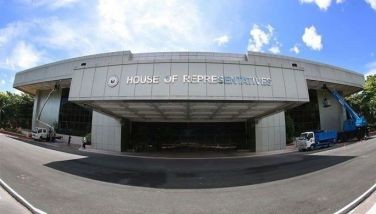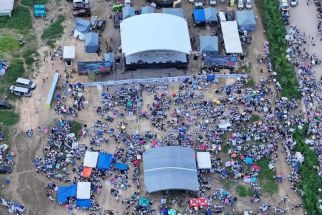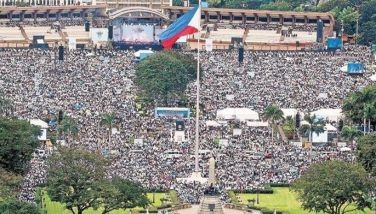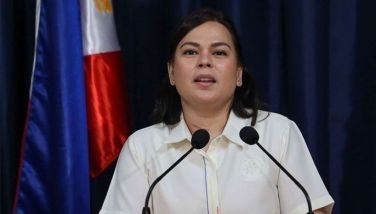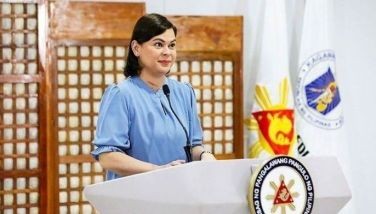End of the line for reluctant terrorist
January 21, 2007 | 12:00am
Khaddafy Janjalani had earned his way up to lead one of the most brutal terrorist groups the world has ever seen. The end came in September, and confirmation of his death more than four months later seemed almost anti-climactic.
Southeast Asia’s most wanted terrorist was a boyish looking man in his early thirties who once strolled shopping malls and loved the urban lifestyle before being thrust into the violent world of Islamic terrorism.
After his older brother Abdurajak Abubakar was killed by government forces in 1998, Khaddafy was not even considered ready to lead the Abu Sayyaf, which translates in Arabic as "the bearer of the sword."
Khaddafy was initially adamant that he did not want to become Abu Sayyaf chieftain because of his lack of guerrilla experience. But upon prodding by senior commanders Abu Sabaya and Abu Solaiman he reluctantly agreed to take over the group.
"He was not your typical Islamist," said Chief Superintendent Rodolfo Mendoza, who interrogated Khaddafy in 1995 before his escape from captivity. "He would smoke cigarettes. He was not an Islamic preacher or warrior, but he was young and adventurous."
Born on March 4, 1975 of a Muslim father and Christian mother in Tabuk, Isabela City, Khaddafy grew up in Marawi City and later gave his commitment to the Abu Sayyaf in the mid 1990s as he was already being trained by his older brother’s henchman Jovenal Bruno alias Abu Jihad.
He was then a second year high school student in Isabela City when at 14 years old, he saw his older brother working as a messenger for the Moro National Liberation Front (MNLF).
The MNLF was the main rebel group fighting in Basilan and Mindanao for an Islamic independent state.
Khaddafy, the youngest of the five Janjalani siblings, was inspired by his older brother and decided to commit himself to the cause.
The young rebel often tagged along in underground meetings and helped prepare coffee.
Abdujarak was a teacher in Basilan who had studied in Libya, Syria and Saudi Arabia during the 1980s.
He was a veteran of the war against the Soviet Union in the invasion of Afghanistan.
It was during his stint as a freedom fighter in Afghanistan that he allegedly met Osama bin Laden who gave him financial support to establish a group to continue the cause from dissatisfied and hard core MNLF fighters.
Abdurajak then returned home to Basilan in 1990 and gathered radical members of the MNLF to found the Abu Sayyaf, named after his own nom de guerre when he fought alongside the mujahedin against the Soviets in Afghanistan.
When the MNLF signed the peace agreement with the government in the 1995, Abdujarak led the separate call of the radical group to continue the cause by launching large scale and bombing attacks.
At some point in the early 90s, Khaddafy joined his older brother but his career was cut short after he was caught.
Khaddafy was among the terrorists who assaulted and burned down the town of Ipil in Zamboanga peninsula in April 1995.
Barely a year after his capture, Khaddafy was able to escape detention, along with his mentor Bruno.
Three years later, Abdujarak was killed in a firefight with policemen in Basilan on Dec. 18, 1998.
This marked the beginning for the younger Janjalani who was later picked to lead the group in respect to his older brother, aside from the personal training given to him.
Janjalani took over and worked to consolidate the fragmented group.
After securing the loyalty of its members, Janjalani took the group into a more lucrative scheme of kidnapping for ransom to finance its operations.
The group gained notoriety when it extended its operations by kidnapping foreign tourists on the island resort of Sipadan, Malaysia in 2000.
Janjalani also led his men into kidnapping dozens of students and teachers in Basilan in the same year.
The Abu Sayyaf gained further international attention when it kidnapped 17 Filipinos and three American tourists in a resort in Palawan in May 2001.
This also earned Janjalani the $5 million bounty on his head from Washington.
Janjalani and his henchmen have been charged for the fire bombing of SuperFerry 14, killing 116 people in one of Southeast Asia’s worst terrorist strikes.
His presence was a constant threat in the region along with the Indonesia-based Jemaah Islamiyah (JI) that wanted to carve out a pan-Islamic region out of Southeast Asia.
A ranking local official who has witnessed the changing of the guard in the Abu Sayyaf said the death of Janjalani and its ranking leaders almost in succession left the terror group in shambles.
"Just like the death of his (older) brother, it left a vacuum and slowed down the group’s terroristic activities," he said.
The official said Janjalani’s death has left only Isnilon Hapilon as the last of the five Basilan-based bandit group leaders after the recent loss of Jainal Antel Sali Jr., alias Abu Solaiman, who was killed Tuesday in Talipao, Sulu.
"It would be hard for the Basilan group to re-group but the leadership might be temporarily carried over by Hapilon who remained as the only one alive from the five leaders," the official said.
Aside from Janjalani and Solaiman, among those killed were Aldam Tilao alias Abu Sabaya, and Hamsiraji Sali, all Basilan-based leaders of the Abu Sayyaf wanted by the US government.
The military in Basilan disclosed that they are monitoring the presence of Hapilon in the province after reportedly escaping from Sulu last year.
The local official pointed out the neutralization of Hapilon could wipe out leadership of the Abu Sayyaf as far as Basilan is concerned.
"With Khadaffi’s confirmed death, if it’s true, then most of his followers might just dissipate and try to hide away," the official said.
The Sulu-based group meanwhile is rooting for a younger and more radical Albader Parad as leader.
"It is also likely that hands from the Jemaah Islamiyah (JI) will be seen in helping the Abu Sayyaf group with their reported merging," the source said but did not elaborate.
The official said Hapilon now commands about 60 followers.
The military in Sulu also estimate the Abu Sayyaf might not be more than 200 divided under Parad, Radullan Sahiron (considered as the Sulu-based Abu Sayyaf patriarch), and Umbra Jumdail alias Dr. Abu Pula.
The deaths of Janjalani and Solaiman leave Sahiron, a one-armed commander, Hapilon and Pula among the senior Abu Sayyaf veterans still active, along with about 400 followers.
The aging Sahiron initially groomed his son Ismin but who was killed in an encounter with the military last year.
Pula reportedly yielded to Parad, being the youngest, according army intelligence unit feedbacks in Sulu. — With AP
Southeast Asia’s most wanted terrorist was a boyish looking man in his early thirties who once strolled shopping malls and loved the urban lifestyle before being thrust into the violent world of Islamic terrorism.
After his older brother Abdurajak Abubakar was killed by government forces in 1998, Khaddafy was not even considered ready to lead the Abu Sayyaf, which translates in Arabic as "the bearer of the sword."
Khaddafy was initially adamant that he did not want to become Abu Sayyaf chieftain because of his lack of guerrilla experience. But upon prodding by senior commanders Abu Sabaya and Abu Solaiman he reluctantly agreed to take over the group.
"He was not your typical Islamist," said Chief Superintendent Rodolfo Mendoza, who interrogated Khaddafy in 1995 before his escape from captivity. "He would smoke cigarettes. He was not an Islamic preacher or warrior, but he was young and adventurous."
Born on March 4, 1975 of a Muslim father and Christian mother in Tabuk, Isabela City, Khaddafy grew up in Marawi City and later gave his commitment to the Abu Sayyaf in the mid 1990s as he was already being trained by his older brother’s henchman Jovenal Bruno alias Abu Jihad.
He was then a second year high school student in Isabela City when at 14 years old, he saw his older brother working as a messenger for the Moro National Liberation Front (MNLF).
The MNLF was the main rebel group fighting in Basilan and Mindanao for an Islamic independent state.
Khaddafy, the youngest of the five Janjalani siblings, was inspired by his older brother and decided to commit himself to the cause.
The young rebel often tagged along in underground meetings and helped prepare coffee.
Abdujarak was a teacher in Basilan who had studied in Libya, Syria and Saudi Arabia during the 1980s.
He was a veteran of the war against the Soviet Union in the invasion of Afghanistan.
It was during his stint as a freedom fighter in Afghanistan that he allegedly met Osama bin Laden who gave him financial support to establish a group to continue the cause from dissatisfied and hard core MNLF fighters.
Abdurajak then returned home to Basilan in 1990 and gathered radical members of the MNLF to found the Abu Sayyaf, named after his own nom de guerre when he fought alongside the mujahedin against the Soviets in Afghanistan.
When the MNLF signed the peace agreement with the government in the 1995, Abdujarak led the separate call of the radical group to continue the cause by launching large scale and bombing attacks.
At some point in the early 90s, Khaddafy joined his older brother but his career was cut short after he was caught.
Khaddafy was among the terrorists who assaulted and burned down the town of Ipil in Zamboanga peninsula in April 1995.
Barely a year after his capture, Khaddafy was able to escape detention, along with his mentor Bruno.
Three years later, Abdujarak was killed in a firefight with policemen in Basilan on Dec. 18, 1998.
This marked the beginning for the younger Janjalani who was later picked to lead the group in respect to his older brother, aside from the personal training given to him.
Janjalani took over and worked to consolidate the fragmented group.
After securing the loyalty of its members, Janjalani took the group into a more lucrative scheme of kidnapping for ransom to finance its operations.
The group gained notoriety when it extended its operations by kidnapping foreign tourists on the island resort of Sipadan, Malaysia in 2000.
Janjalani also led his men into kidnapping dozens of students and teachers in Basilan in the same year.
The Abu Sayyaf gained further international attention when it kidnapped 17 Filipinos and three American tourists in a resort in Palawan in May 2001.
This also earned Janjalani the $5 million bounty on his head from Washington.
Janjalani and his henchmen have been charged for the fire bombing of SuperFerry 14, killing 116 people in one of Southeast Asia’s worst terrorist strikes.
His presence was a constant threat in the region along with the Indonesia-based Jemaah Islamiyah (JI) that wanted to carve out a pan-Islamic region out of Southeast Asia.
"Just like the death of his (older) brother, it left a vacuum and slowed down the group’s terroristic activities," he said.
The official said Janjalani’s death has left only Isnilon Hapilon as the last of the five Basilan-based bandit group leaders after the recent loss of Jainal Antel Sali Jr., alias Abu Solaiman, who was killed Tuesday in Talipao, Sulu.
"It would be hard for the Basilan group to re-group but the leadership might be temporarily carried over by Hapilon who remained as the only one alive from the five leaders," the official said.
Aside from Janjalani and Solaiman, among those killed were Aldam Tilao alias Abu Sabaya, and Hamsiraji Sali, all Basilan-based leaders of the Abu Sayyaf wanted by the US government.
The military in Basilan disclosed that they are monitoring the presence of Hapilon in the province after reportedly escaping from Sulu last year.
The local official pointed out the neutralization of Hapilon could wipe out leadership of the Abu Sayyaf as far as Basilan is concerned.
"With Khadaffi’s confirmed death, if it’s true, then most of his followers might just dissipate and try to hide away," the official said.
The Sulu-based group meanwhile is rooting for a younger and more radical Albader Parad as leader.
"It is also likely that hands from the Jemaah Islamiyah (JI) will be seen in helping the Abu Sayyaf group with their reported merging," the source said but did not elaborate.
The official said Hapilon now commands about 60 followers.
The military in Sulu also estimate the Abu Sayyaf might not be more than 200 divided under Parad, Radullan Sahiron (considered as the Sulu-based Abu Sayyaf patriarch), and Umbra Jumdail alias Dr. Abu Pula.
The deaths of Janjalani and Solaiman leave Sahiron, a one-armed commander, Hapilon and Pula among the senior Abu Sayyaf veterans still active, along with about 400 followers.
The aging Sahiron initially groomed his son Ismin but who was killed in an encounter with the military last year.
Pula reportedly yielded to Parad, being the youngest, according army intelligence unit feedbacks in Sulu. — With AP
BrandSpace Articles
<
>
- Latest
- Trending
Trending
Latest
Trending
Latest
Recommended















